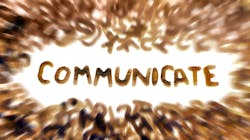Communication with peace of mind, part 1
Communication is a critical management tool for any business and is essential for efficient workflow, productivity, outcomes, and security. Effective communication brings peace of mind to health-care professionals and best outcomes to patients.
In part one of this three-part series, I’ll introduce today's challenges and solutions integrating effective communication with emerging technologies and digital workflow.
There are two central assumptions when selecting communication options: first, respect security and privacy. All applications, networks, and services should provide the security required by the federal government and HIPAA. Second, understand the concept of technical communication, which is critical for exchanging information in health care.
In health care, technical communication is about defining, creating, and delivering information for safe, efficient and effective use. It’s about providing the right information in the right way, at the right time to improve the health of patients and make caregivers’ lives easier and more productive.
Examples of technical communication
- Information that accompanies and follows a specialty referral
- Lab prescriptions and the collaboration and conversations that follow
- Preparation and follow-up to manage a patient's surgical experience
- Distant patient consults and case management
- Managing access and effective use of digital information collected over the life of a patient's treatment and care
The problem
Technical communication for managing patient care requires sharing and storing information, collaboration, and conversations between members of the care team. The information must be easily accessible and more than a snapshot of a single moment. The information should be available during and after the patient treatment experience.
New technologies and products may create challenges for collaboration that create pain points. They often provide closed proprietary networks limited to a specific data set and a specific closed endpoint. They seldom address the entire care team or the importance of collaboration and conversation, and they add costs for use and conversion of proprietary formats to open standards when available. In these situations, the caregiver has to manage how to extract the information and make it more useful.
It's not the purpose of this article to judge specific products and channels, but we will address this issue in more detail in future articles.
A simple example is a secure email. Some security systems have a validation process for HIPAA that can be confusing, complicated, limit collaboration, exclude conversation, and a barrier to adoption. Some solutions focus on the mobile environment and require downloading apps that can also lead to limitations in functionality and obstacles to patient adoption.
A second example relates to the management of digital files from intraoral scanners. In some cases, the information is acquired as a proprietary format rather than an open standards STL file, which is universally applicable. The proprietary gives a vendor the opportunity to charge fees for access to files through proprietary channels and charge license fees to convert the proprietary file to an open standards STL file.
The solution
Wouldn't it be nice to have a single cost-effective solution to address HIPAA compliance, document sharing, collaboration, and conversation with all dental team members, colleagues, labs, patients, and suppliers? The world of communication has many emerging technologies to improve technical communication and the user experience, including HIPAA-compliant text messaging, voice applications with artificial intelligence, and virtual assistants.
I'll focus on texting as a tool for peace of mind.
Texting
Where do you communicate when you want a quick response? What do you use instead of a phone call and voicemail? Where do you turn to share information, experiences, or an image? You likely text. It is well documented that texting is the most efficient method to communicate, replacing the phone as a conversational tool.
- Texting is the most widely used app on a smartphone. (Acision)
- Over 80% of American adults text. (Pew Internet)
- Text messages have a 98% open rate while email has only a 20% open rate. (Mobile Marketing Watch)
- 90% of all text messages are read in under three minutes. (Connect Mogul)
- It takes the average person 90 minutes to respond to an email but only 90 seconds to respond to a text. (CTIA)
The challenge
There are several texting apps for health care, and most focus on institutional services. Also, HIPAA-compliant texting apps focus on the desktop or mobile experience and may require downloading the mobile app.
The first challenge is to commit to HIPAA compliance. The second challenge is to commit to separating social from personal communications. The third challenge is to select a platform that can support the technical communication required to manage a patient's journey. The fourth challenge is to find a platform that pays equal attention to the desktop and mobile experiences. The next challenge is to review your current approach to technical communication with colleagues, patients, labs, and suppliers and how it impacts peace of mind.
Some selection criteria and questions when choosing products or technology should include:
- Can I use this app for more than one use?
- Is it simple to use and teach?
- Is it mobile- and desktop-friendly?
- Can I use it to communicate with a variety of people in the dental community?
- Is it dependent on an app that must be downloaded?
- Is it easy to engage patients and labs?
- Does it support multiple digital file formats?
- Does it support collaboration and conversation?
- Is it cost-effective?
- Is there potential for integration to third-party applications?
- Does it support voice and AI applications?
Finally, invest time when adopting a communication solution to ensure that it addresses your needs and provides peace of mind.
In future articles, I will discuss these questions and how they can impact your peace of mind and the efficiency, productivity, outcomes, and user experience of your practice.
Arnold Rosen, DDS, MBA, has trained in prosthodontics at Boston University, maxillofacial prosthetics at Memorial Sloan Kettering, and has an MBA from Boston University. He served as director of hospital dentistry at New England Medical Center and is founder and director of the Dental Implant Center at Tufts University. Dr. Rosen cofounded Global Telemedix, one of health care's first telemedicine providers, and launched Awrel LLC, the first company to offer HIPAA-compliant texting and voice-enabled solutions for the dental industry. Contact Dr. Rosen at (617) 549-4418 or [email protected].
About the Author

Arnold Rosen, DDS, MBA
Arnold Rosen, DDS, MBA, has trained in prosthodontics at Boston University, maxillofacial prosthetics at Memorial Sloan Kettering, and has an MBA from Boston University. He served as director of hospital dentistry at New England Medical Center and is founder and director of the Dental Implant Center at Tufts University. Dr. Rosen cofounded Global Telemedix, one of health care's first telemedicine providers, and launched Awrel LLC, the first company to offer HIPAA-compliant texting and voice-enabled solutions for the dental industry. Contact Dr. Rosen at (617) 549-4418 or [email protected].
